How to choose kitchen flooring - expert advice for a stylish yet functional finish
Knowing how to choose kitchen flooring, and deciding between wood, marble, porcelain, stone, concrete or LVT allows you to create a functional and design-forward space
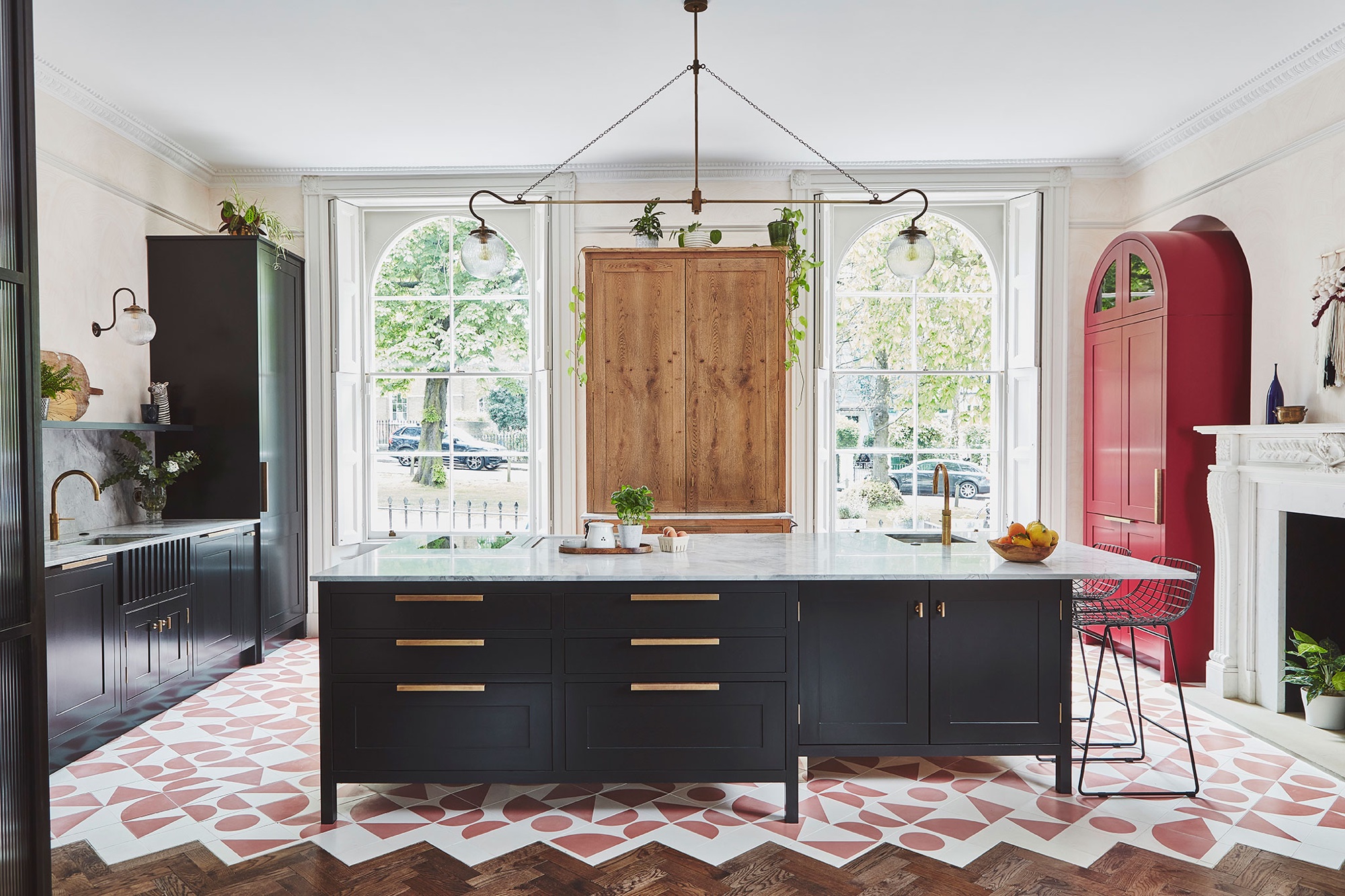
You need to know how to choose kitchen flooring - it's not just something you can pick based on color alone. You'll need to take into account a host of factors, including aesthetics to suit your decor and, of course, durability.
'Flooring is a huge subject when it comes to kitchen ideas, but practicality and personal taste are key considerations,' says Adrian Bergman, Design Manager at British Standard by Plain English.
'Any kitchen flooring ideas are likely to have a hard life so delicate surfaces are a poor idea,' he adds. 'Classic solutions include wood, stone or tiles.'
Helen Parker, deVOL's Creative Director advises: 'Invest in a great floor if you don’t have an original.
'There is nothing more of a shame than a beautiful room with a poorly considered floor choice. I’m erring on the side of wood at the moment but patterned ceramic tiles, marble tiles and terracotta tiles are all beautiful choices.'
How to choose kitchen flooring
"Believe it or not, the aesthetics of a kitchen floor is probably one of the last things you need to think about when choosing what to lay in your kitchen."
Oana Sandu, Lead Designer, Blakes
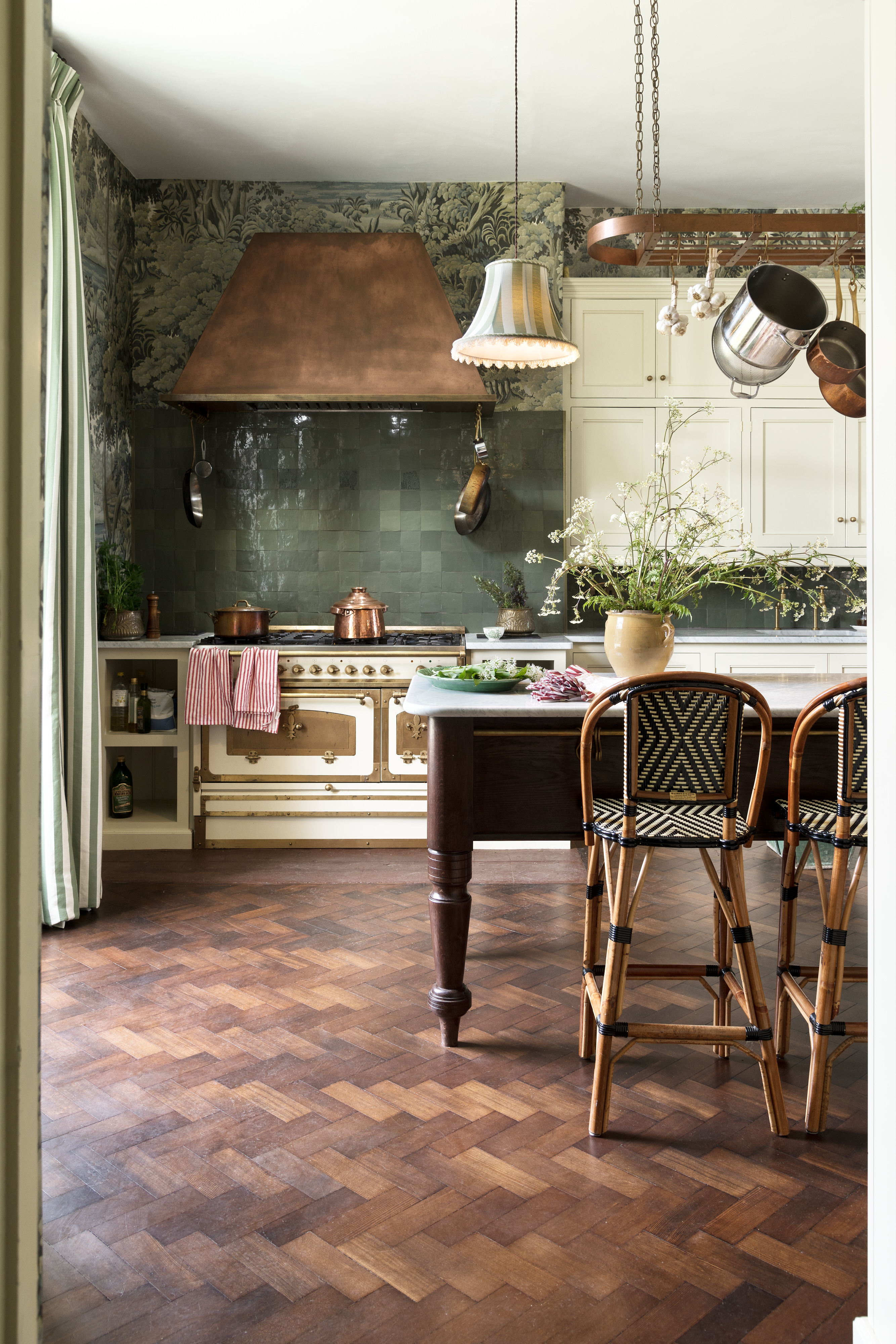
1. Consider the practicalities
The old saying goes that the kitchen is the heart of the home - and that is true now more than ever. Modern kitchen ideas need to offer a multi-use space, including a cooking zone, a hangout hub, a homework station, and a socializing epicenter.
When it comes to choosing your kitchen flooring, you need to be sure it will withstand this busy lifestyle while also offering the functions you require: Is the flooring suitable for heavy foot traffic? Can it be used with underfloor heating? Does it need sealing regularly?
'There are a large number of things to take into consideration when choosing a kitchen floor, and the earlier in the process or your kitchen design that you decide on the style of floor the more options you will leave yourself,' explains Oana Sandu, Lead Designer, Blakes London.
'Believe it or not, the aesthetics of a kitchen floor is probably one of the last things you need to think about when choosing what type of floor to lay in your kitchen. We would recommend starting with the practicalities of what your floor needs to do for you.'
Oana suggests looking cloesly at the way you live. 'Do you have children or animals, does the floor lead to a garden, how many hours do you spend standing in the space?' she asks. 'Does the room have another purpose other than just cooking, how much maintenance do you want to do, does your floor need to look as new or can you cope with a lived-in look, what is your budget?'
'By drilling down on these sorts of questions it tends to become apparent what style of floor is going to work best in your home. At that point you can start to think about the aesthetic implications of your short list of flooring materials.'
And Grazzie Wilson Creative Lead at Ca’ Pietra, says it's important not to focus solely on flooring trends. 'You might love a particular product, but it's so important to check that a tile or flooring choice will work in the intended space,' she says. 'The last thing you want are cracked tiles or stone that is slippery when laid in an unsuitable area.'
Porcelain tiles are ideal for underfloor heating systems. 'Plus, they’re a more affordable option than natural stone,' Grazzie says. 'But, if you’ve been dreaming of a limestone or marble floor then rest assured that they too are great conductors of heat. Likewise with terracotta, underfloor heating is perfect for this material.'
The best types of kitchen flooring
We've tapped a host of experts to give you the lowdown on how to choose the best floor types for your kitchen, from aesthetics to practicality.
1. Natural stone floor tiles
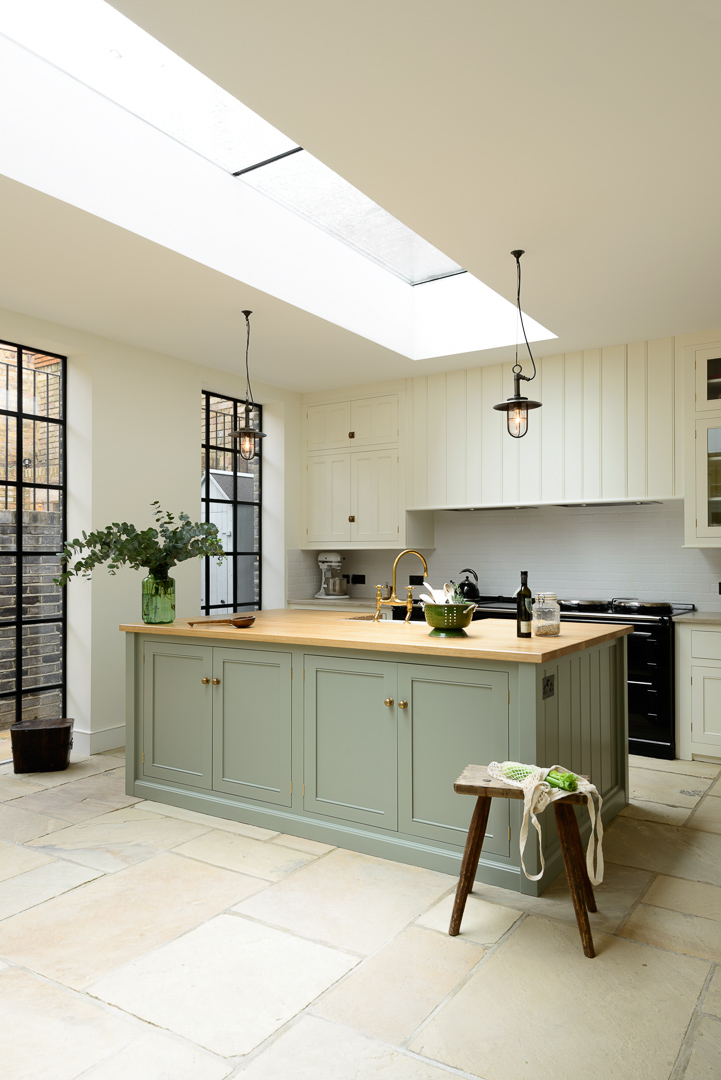
'If you are looking for something truly timeless then natural stone is a great choice,' says Grazzie Wilson Creative Lead at Ca’ Pietra. 'The beauty of natural stone is that it becomes lived-in and develops an aged patina.'
When remodelling a kitchen and choosing a natural stone, it’s always important to think about how the space is going to be used. 'Is it a slick apartment or a country home?' Grazzie asks. 'Who will be using the space? And what is the lifestyle of the user? Sometimes a very clean and minimalistic look is required for a contemporary space and a very clean and consistent color stone will be required. However, if it’s a family home and there is a lot of lifestyle activity with socialising and entertaining, cooking and family, sports and pets, then a more characterful floor with fossil content, texture and tonal variation will withstand the most active of lifestyles.'
Large limestone tiles (as seen in the deVOL kitchen above) are ideal for an airy feel in a country pad. Grazzie says: 'When it comes to natural stone, you can choose from sandstone, limestone, marble and terracotta (to name a few). Limestone is certainly one of our most popular products thanks to the options available in this versatile material, from buttery limestone shades with tumbled edges to more contemporary tones with etched edges. Limestone also ages beautifully over time and looks like it has always been part of the home.'
Checkerboard marble tiles can create a lovely heritage look (below), and cement tiles come in beautiful patterns, although can be prone to staining.
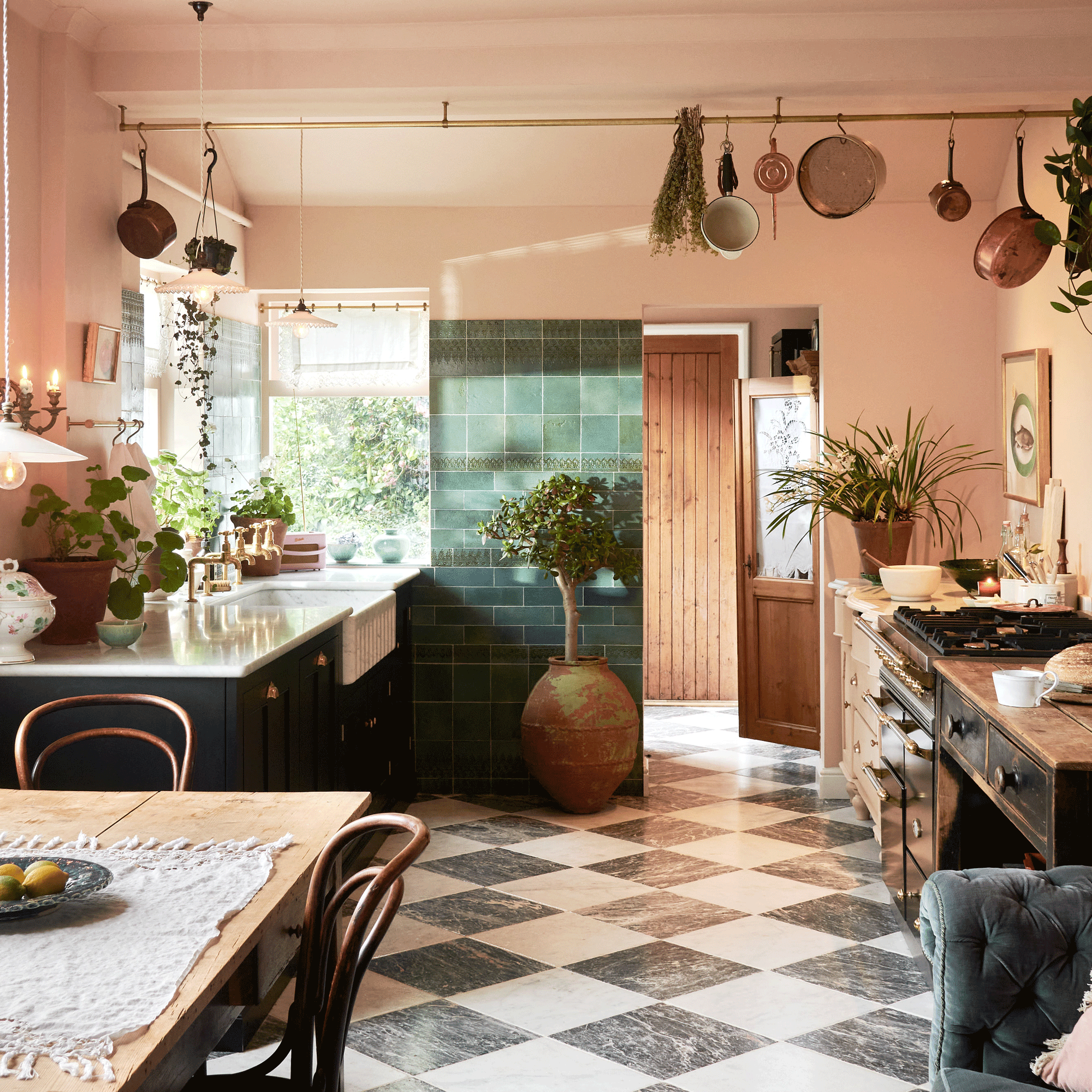
Meanwhile, deep grey slate or dark limestone can add a dramatic effect, and brick flooring offers that earthy, back-to-nature look that's really trending (below).
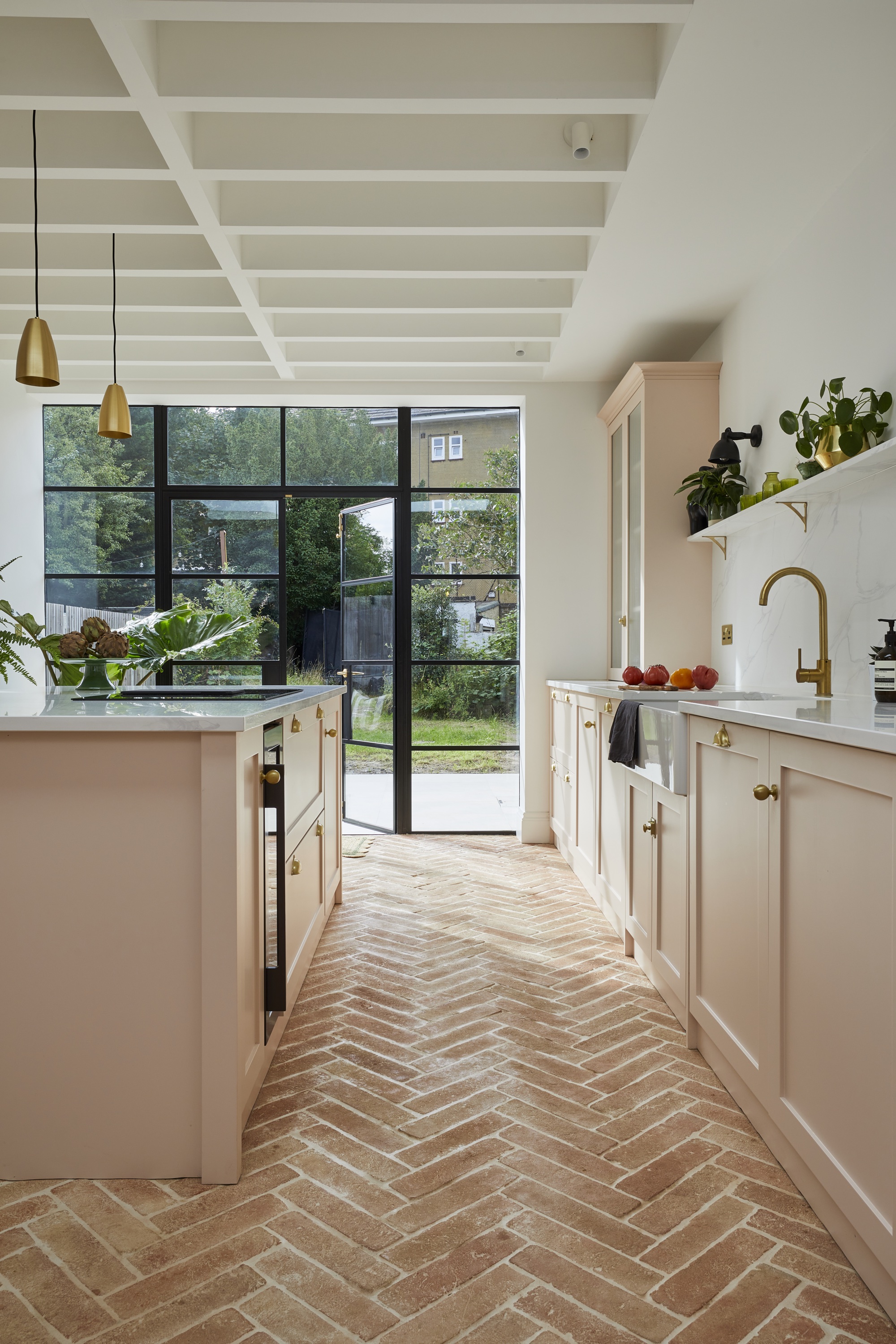
If you've gone for these modern farmhouse kitchen ideas, you need to make sure you treat them correctly. Grazzie adds: 'Don’t allow your efforts in finding the right tiles for your project to be in vain. If you have purchased natural stone, or tiles that require sealing, it is important to ensure you seal them correctly and with the right product for the job. We recommend using lighter coloured grouts for most products, in particular natural stone, encaustic and terrazzo tiles, rather than black or bright colors as these can cause staining in the natural pores of the tiles. '
Emma Hughes, Studio Manager at Original Style, adds: 'Natural stone floor tiles are great for incorporating organic textures and neutral hues to create a rustic interior scheme. Choose from limestone, slate and even real marble, all of which provide an authenticity that will reward you for years to come.'
2. Porcelain tiles
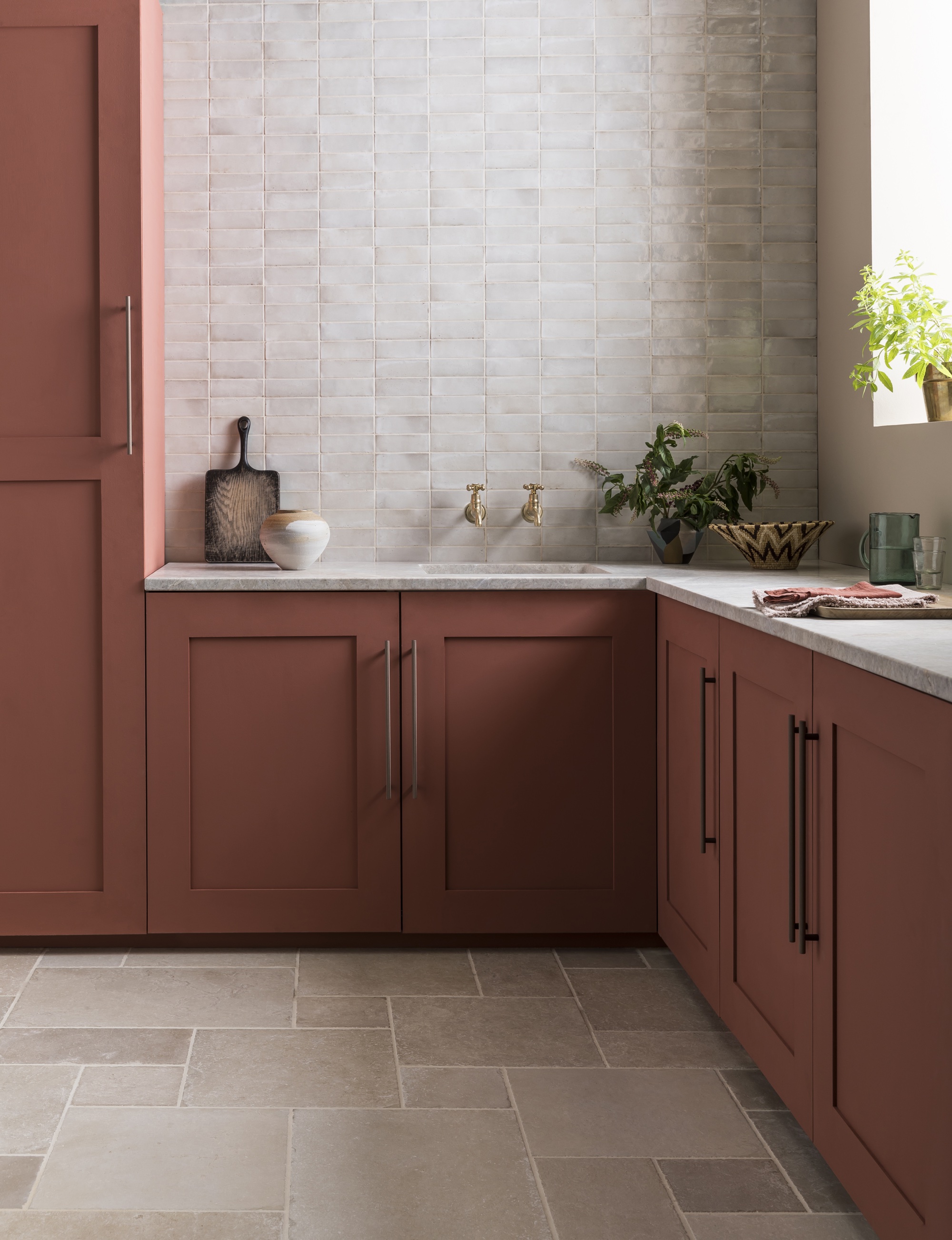
If easy maintenance is top of your kitchen flooring wishlist, you can't go wrong with porcelain tiles. They often get used in open plan kitchen ideas, as they feel seamless between cooking and living space.
'Porcelain tiles are increasingly popular as they are extremely durable, available in a huge variety of finishes and tile sizes and require little maintenance - they are waterproof, stain-resistant and scratch-proof,' says Adrian Bergman, Design Manager at British Standard by Plain English. 'If you love the look and feel of wood or natural stone, but need a more practical solution, there are some very good-looking wood-effect, stone-effect, concrete-effect and marble-effect porcelain tiles on the market.'
The above image is a lovely example of a limestone-effect porcelain tile.
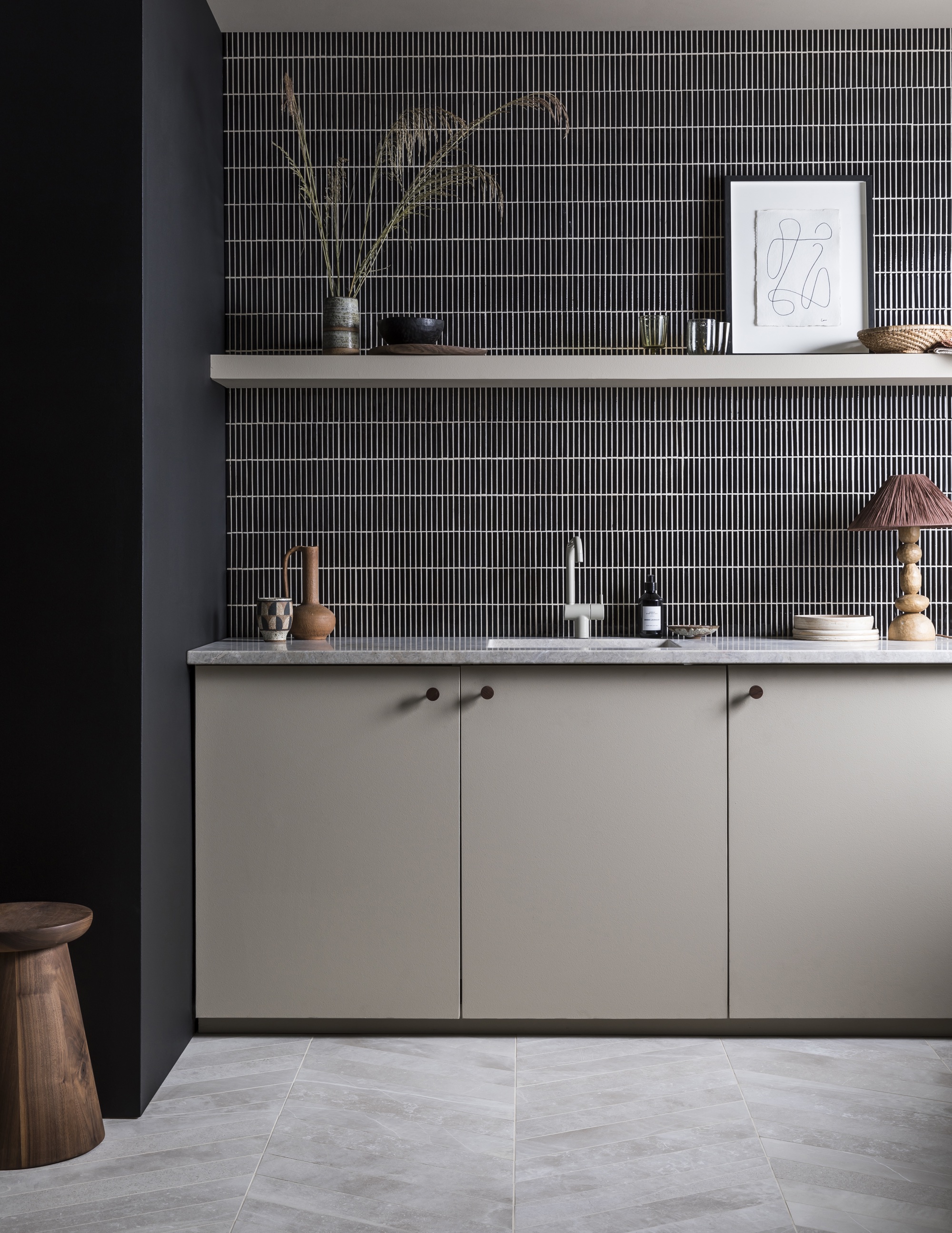
'If you are looking for something super-contemporary, or something that emulates the look of natural stone but with little or no maintenance, then porcelain could be a great option,' says Grazzie Wilson, of Ca'Pietra.
Try indulging in a big trend for 2022 - the neutral-hued terrazzo flooring finish. Applying the look in porcelain tiles ensures easy maintenance and longevity.
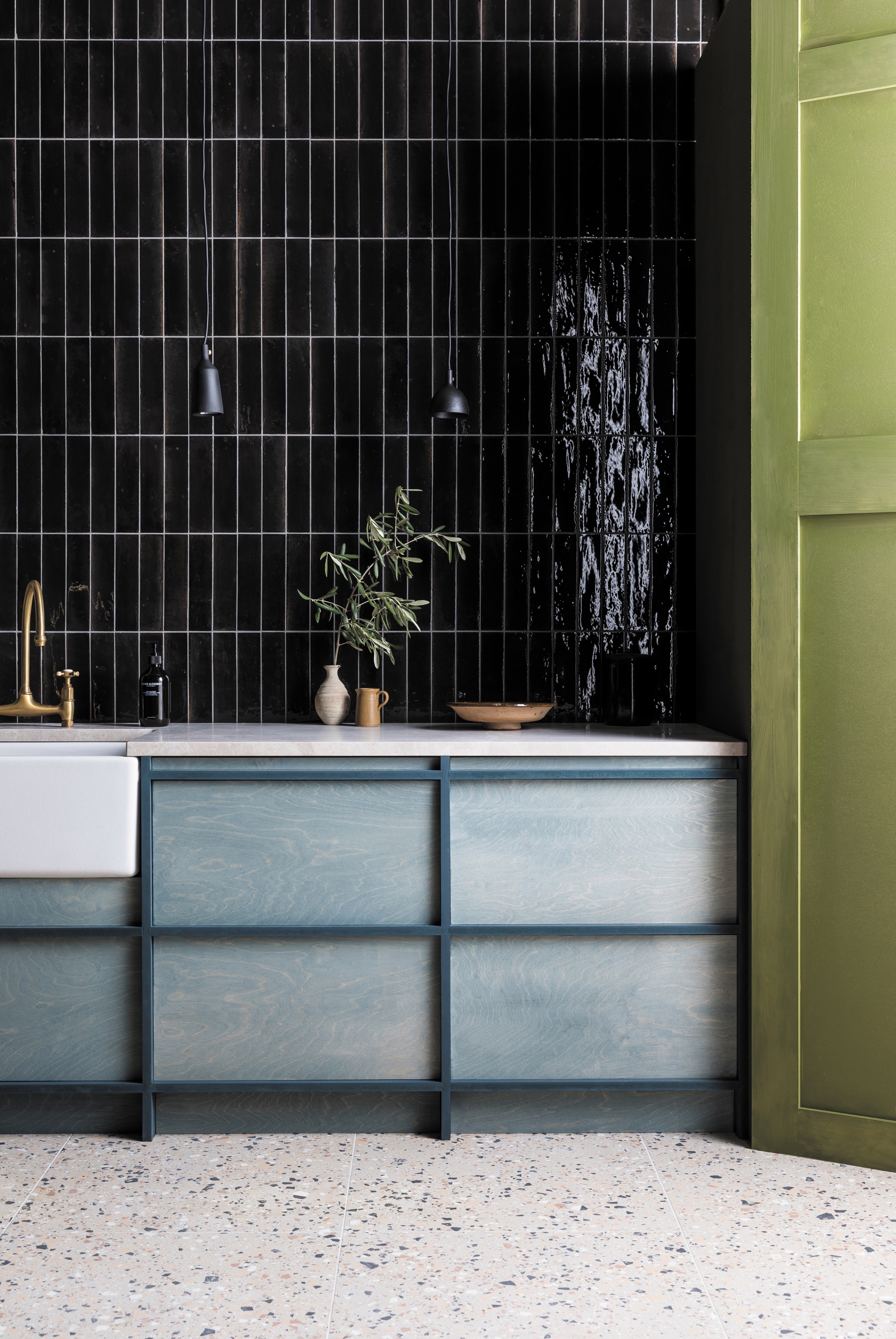
Louisa Morgan, of Mandarin Stone adds: 'This man-made material is extremely durable and offered endless options in terms of shade, finish and format. There are porcelain tiles to suit all styles and budgets.'
3. Wood flooring
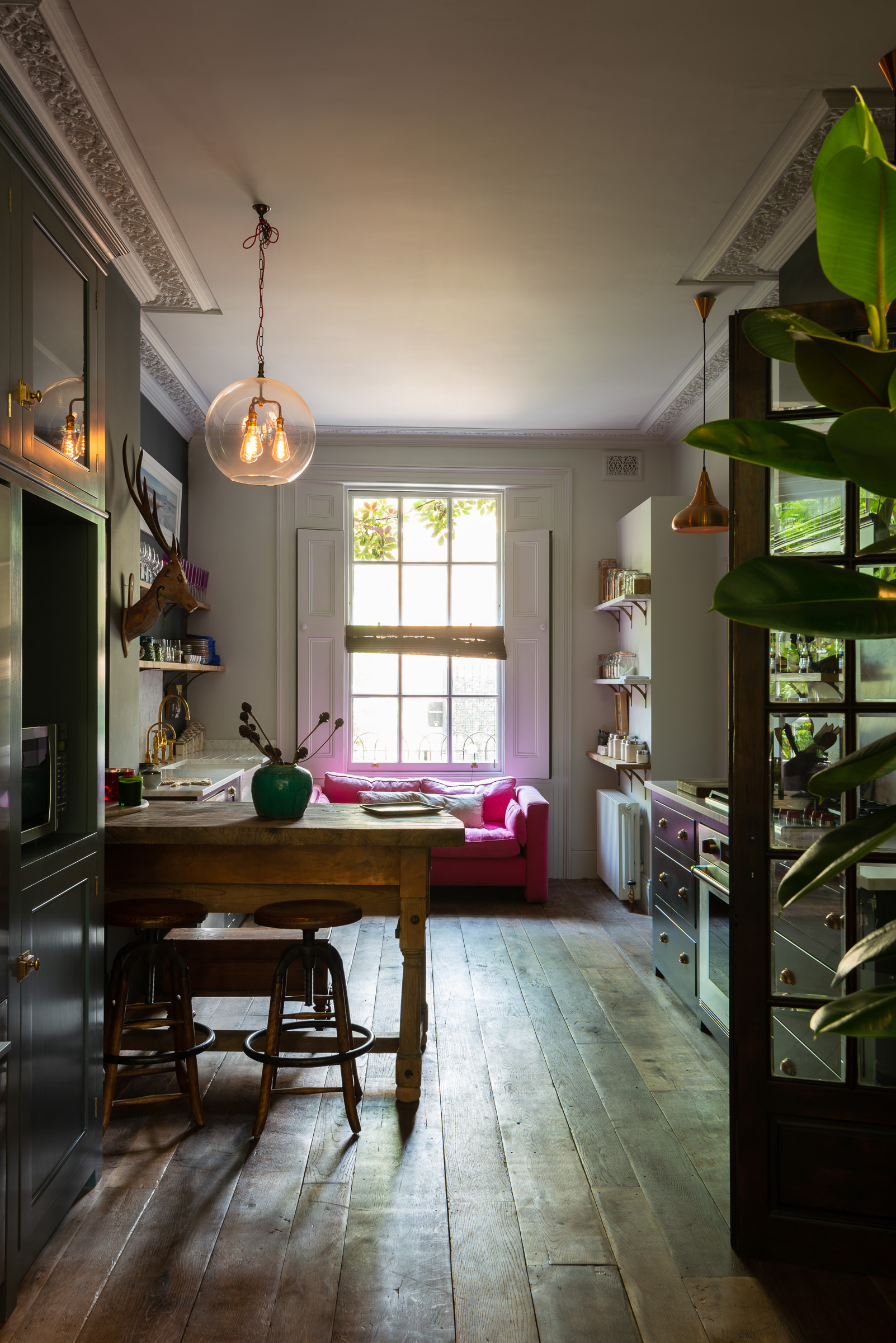
'Timber is timeless and a popular choice for floors,' comments Oana Sandu, Lead Designer, Blakes London. And it's true - wood flooring ideas never seem to go out of style.
'Herringbone offers a slightly more traditional look, chevron is more contemporary and very on-trend at the moment. A nice wide engineered timber is timeless and goes with everything.'
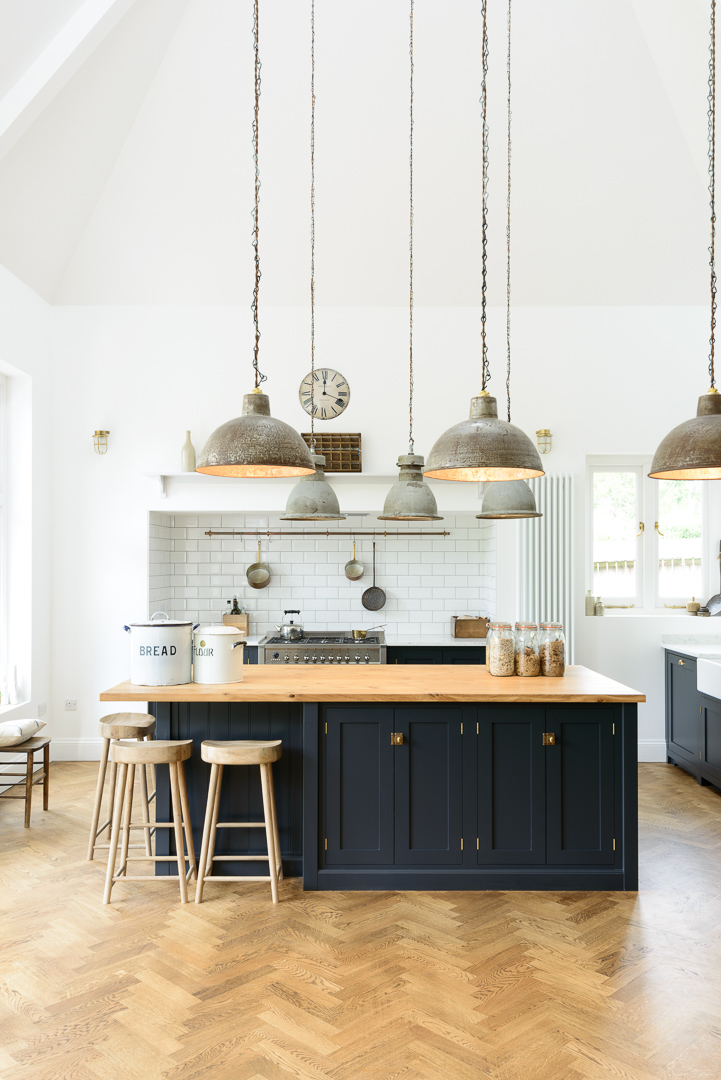
She continues: 'Timber works well with underfloor heating and radiators alike but does take some maintenance. It doesn't like to be wet for prolonged periods of time so around sinks one needs to be careful to mop up any spills and drips. Equally on a stained timber you will likely see wearing over time in high traffic areas around the sink, hob and fridge.'
That said, for people that spend a lot of time in the kitchen it's softer than concrete or tiles underfoot. 'And for families it works well as it is more forgiving if children or objects fall onto it,' Oana says.'For mixed-use spaces like kitchen diners, timber is popular as it offers better acoustic qualities to harder tiled materials and feels cozier if you are thinking about putting soft seating in the kitchen space.'
Reclaimed wood flooring is a lovely idea for a modern rustic farmhouse feel or beautiful vintage vibe, as seen in Pearl Lowe's stunning home below.
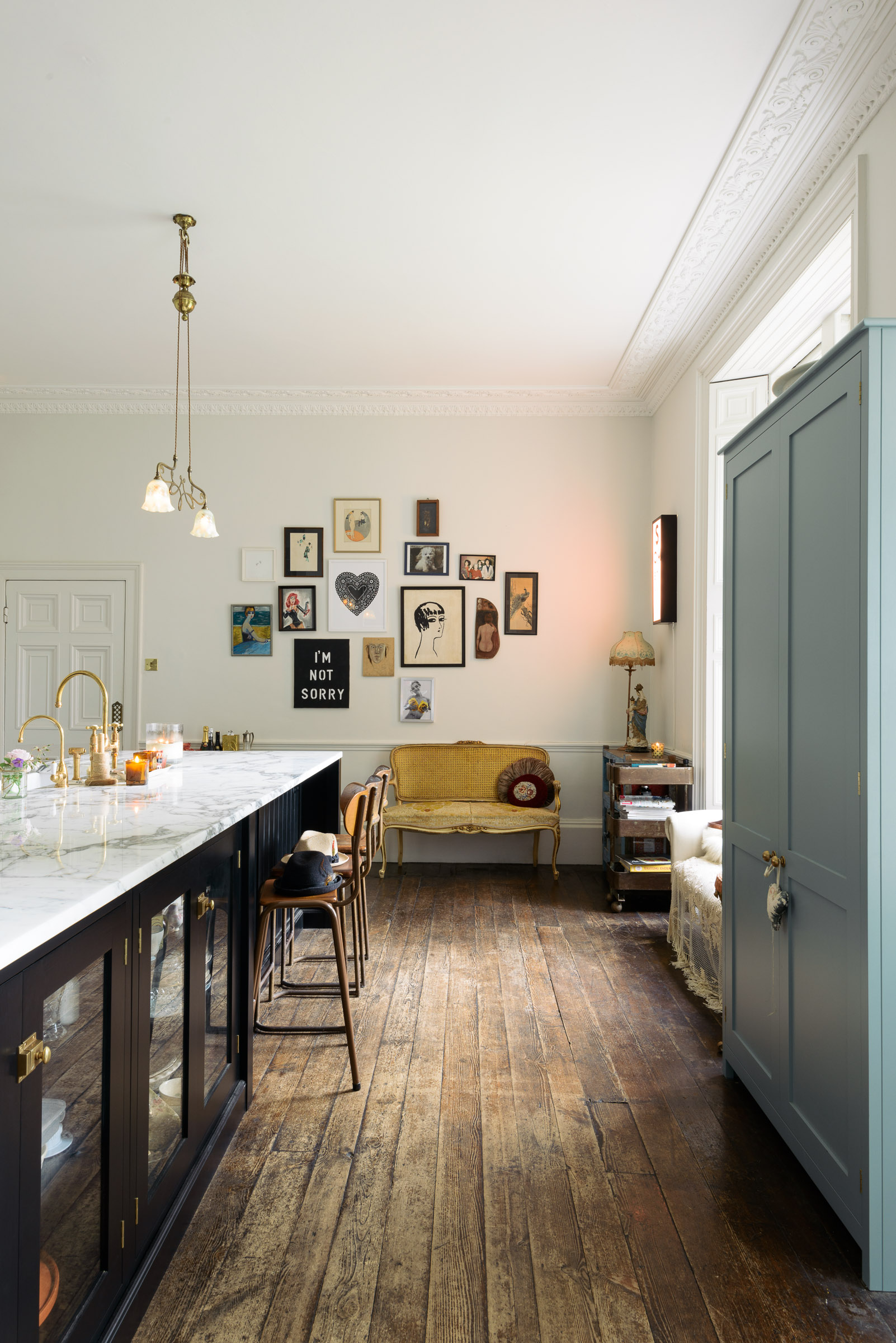
Darker options can be a beautiful addition to a sleek, contemporary kitchen.
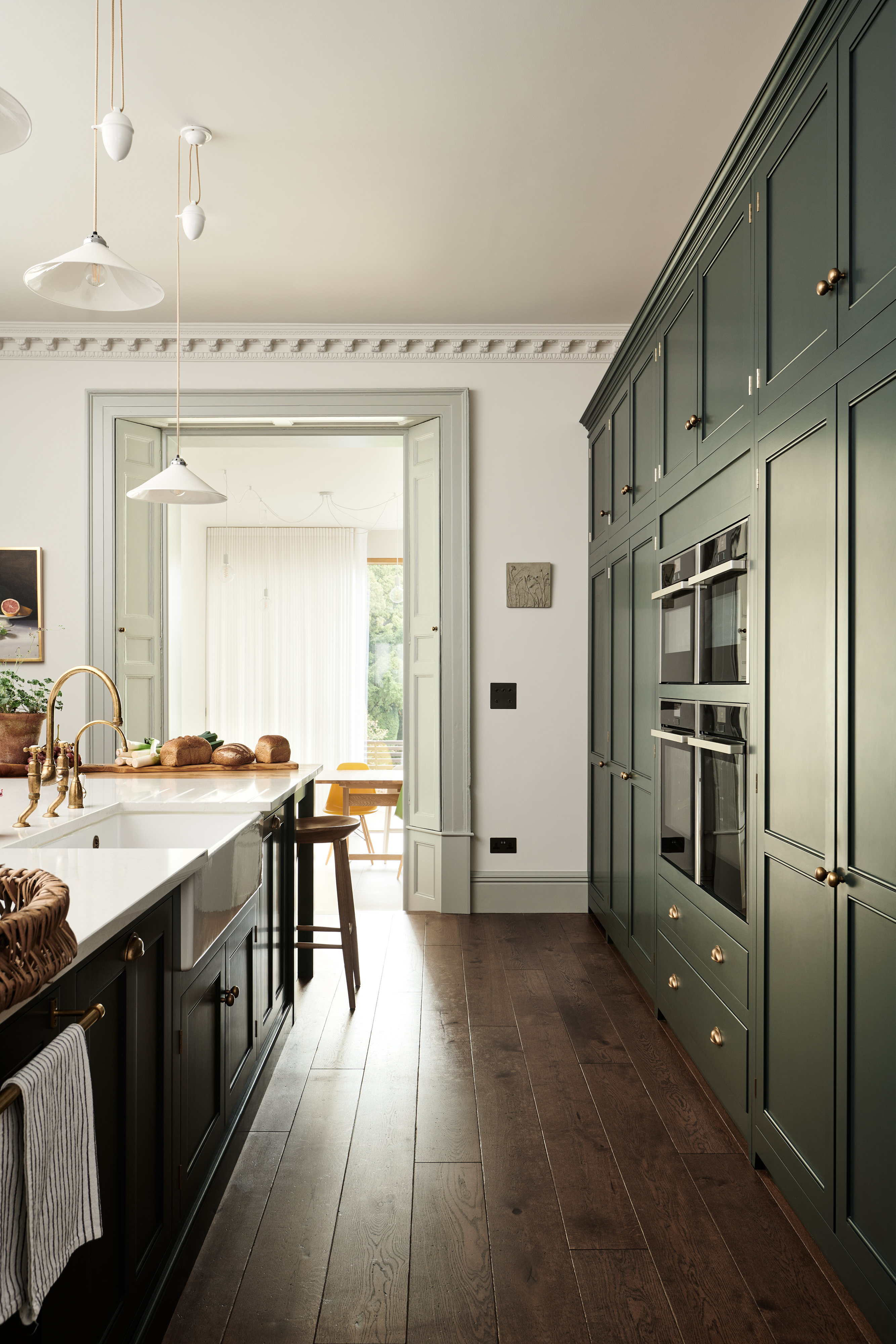
Whitewashed or pale wood options, as seen in this stunning space by deVOL below, are a lovely idea for Scandi style kitchen ideas.
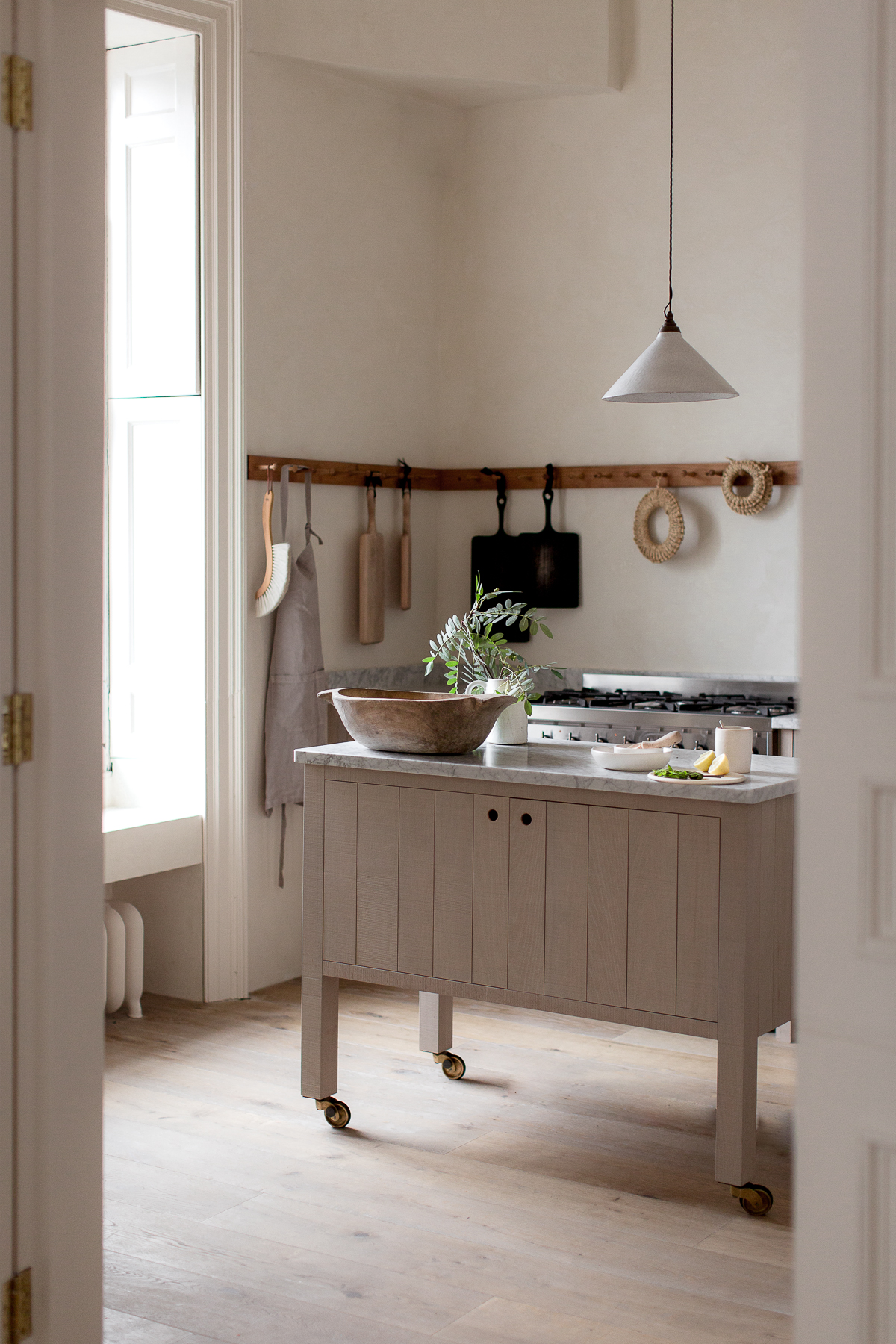
And white painted wood floors will brighten any kitchen and work particularly well in coastal properties, as seen in Pearl Lowe's beach house below.
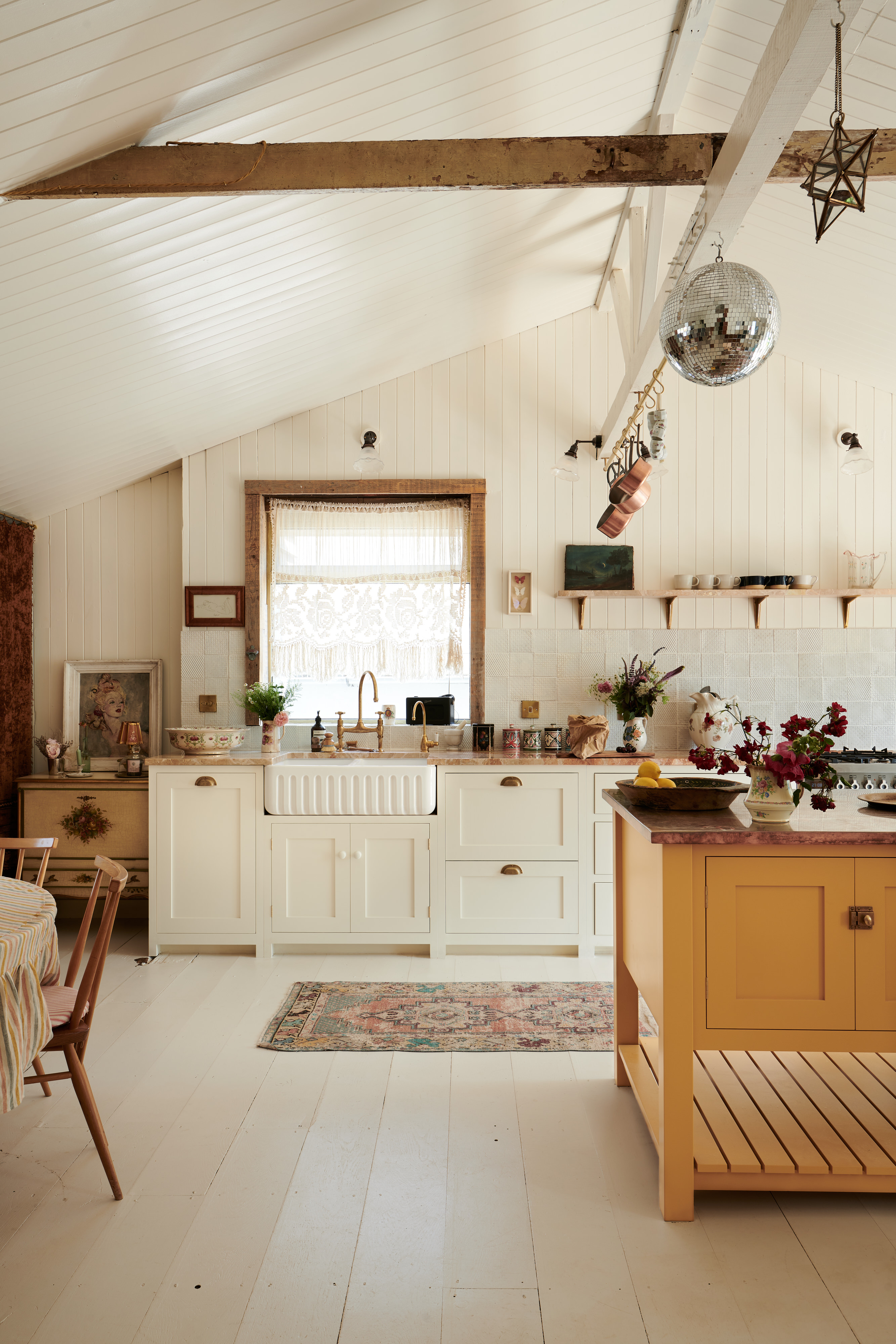
4. LVT
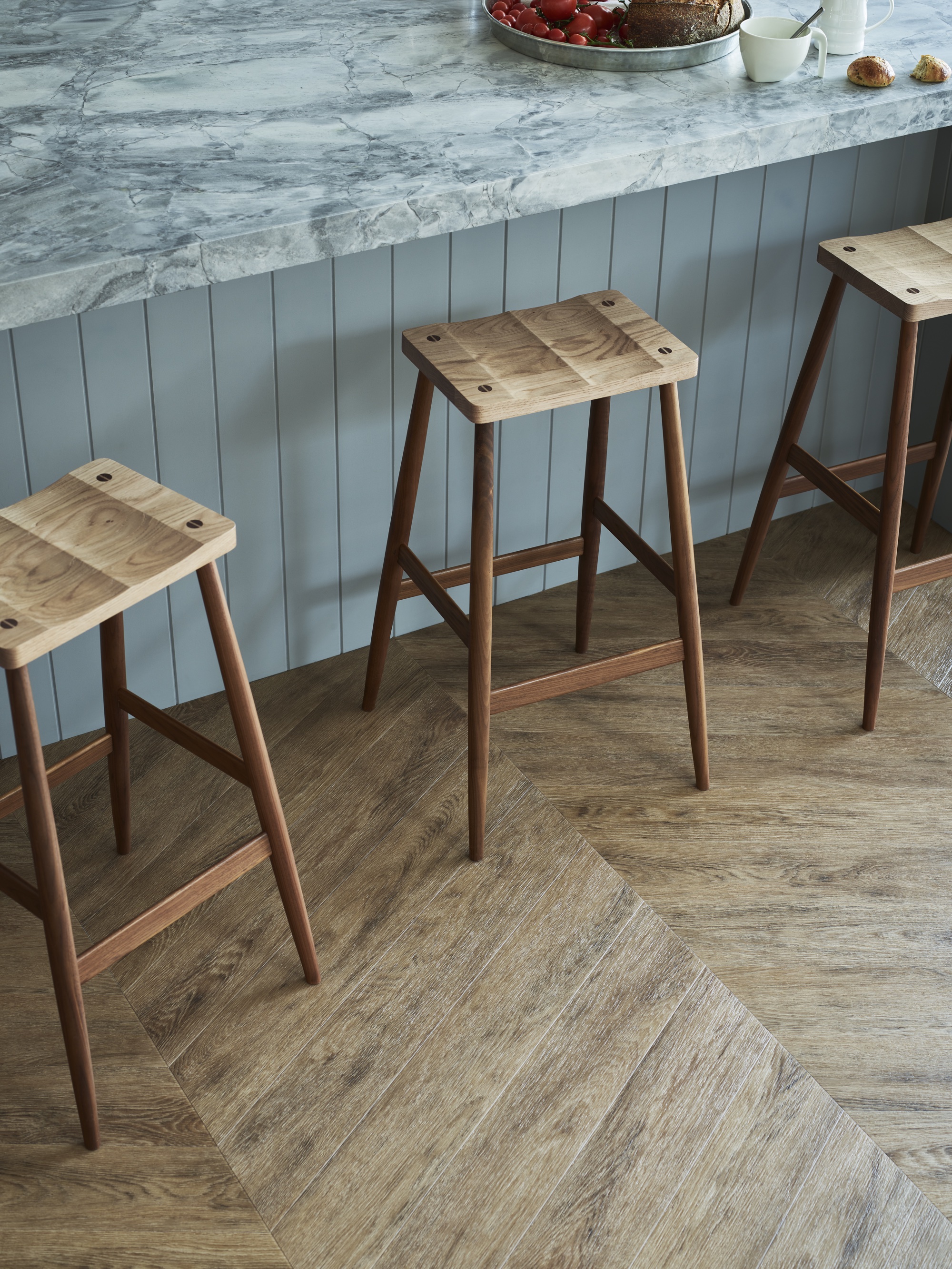
'When choosing a kitchen floor, the big decision is often between LVT (luxury vinyl tile) or real wood/stone or tiles,' says Sarah Escott, Design Manager at Amtico.
'There are advantages to all of them, however LVT boasts a huge number of benefits that simply cannot be replicated with its natural counterparts,' Sarah continues. 'One of these is maintenance. Rooms such as the kitchen or hallway are high-traffic areas in the home, and so picking a floor that requires low maintenance is key. With natural wood or stone, it can be tricky to keep it looking good, as it requires regular treatment. LVT simply requires a sweep and occasional mop to keep it looking fresh. '
As is often the way, it usually comes down to budget. 'To work out how much flooring you’ll need, and therefore how much it will cost, first measure the size of your room,' Sarah says. 'With tile products, you should allow 5-10% wastage depending on the shape of the area being covered. The smaller the area, the higher the wastage factor.'
Aesthetically, LVT can replicate the look of anything from marble checkerboard tiles to wood parquet flooring, and is a good choice for anyone looking for spacious or small kitchen ideas on a budget.
5. Polished concrete and resin
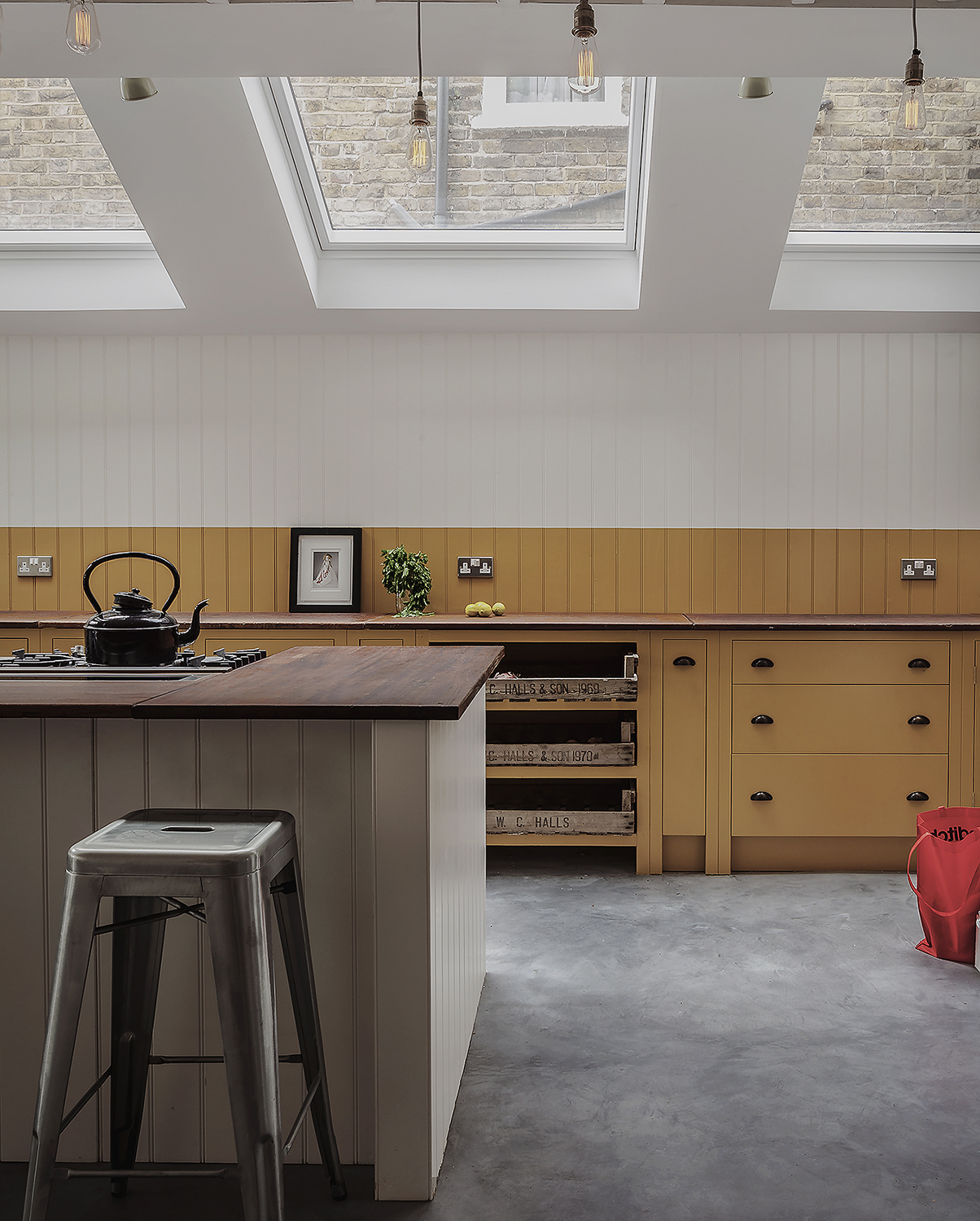
Concrete and resin floors have become increasingly popular kitchen flooring ideas, particularly in high-end projects. Excitingly, colored concrete is now creeping in as a brand new trend.
'Whilst concrete is sometimes more complex and costly to install, a polished concrete floor is easy to maintain [it is resistant to chips], and offers a clean, seamless look,' says Adrian Bergman, Design Manager at British Standard by Plain English. 'As it's becoming more popular, there are now a myriad of color options on the market, some companies can even color match, meaning it's very versatile.'
Oana Sandu, of Blakes London, suggests resin could be a preferable option. She explains: 'Concrete is a popular design-led choice especially for architectural style homes; highly on trend. However, it is expensive to lay, is prone to cracking and, as with all concrete, can stain. Like its popular alternative, resin, both products have to be specified at the outset of a build as it has implications for the flooring substrate.'
Resin, however, doesn't crack as much, and has a quicker drying time which is very helpful for build schedules that are tight and need to remain on track. 'With resin there are also more color options available,' Oana continues. 'And it is also softer than concrete underfoot, which is noticeable for people who spend a lot of time standing in a kitchen.'
And Elizabeth Sherwin, Designer at Naked Kitchens, adds: 'If creating industrial kitchen ideas, or if you have lots of exposed timber in the form of worktops and/or door fronts, you may prefer to choose a more modern, raw texture for your flooring.
'If renovating an open plan space, this is often a popular choice as this finish can run almost seamlessly from room to room.'
What is the most popular floor for kitchens?
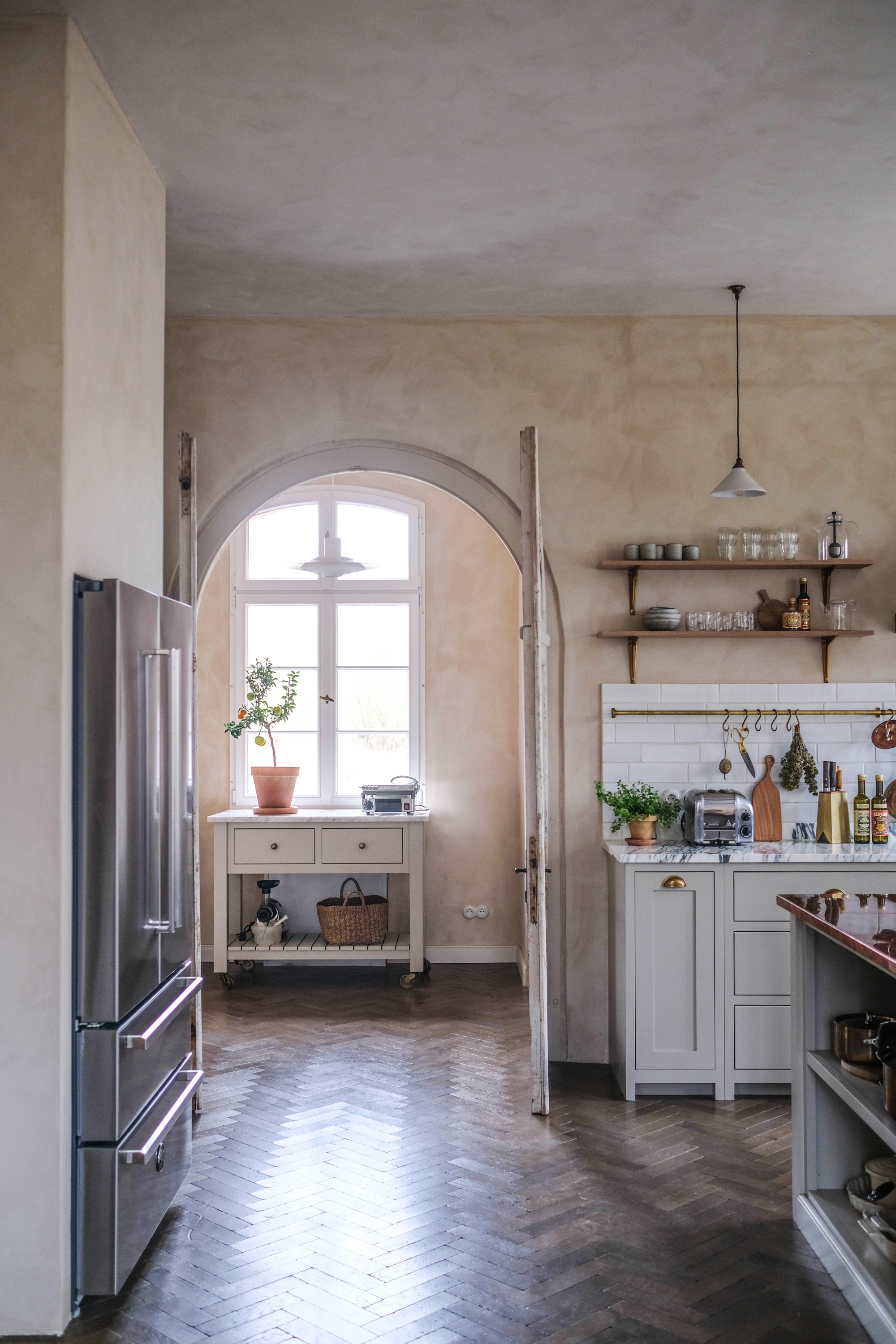
'The most popular floor for kitchens depends on budget,' says Oana Sandu. 'Porcelain floor tiles can be very cost effective and there are lots of fabulous options at all price points so is popular for those on a budget.
'Timber is probably most common across the different price points and for high-end luxury homes, concrete and resin are increasingly popular.'
Naked Kitchens' Elizabeth Sherwin concurs: 'We see the vast majority of clients opting for timber flooring - whether this be parquet, herringbone, or lovely wide planks,' she says. 'Many clients completing renovation works or creating an extension, will be selecting engineered flooring. Second to timber, polished concrete or microcement is incredibly popular.'
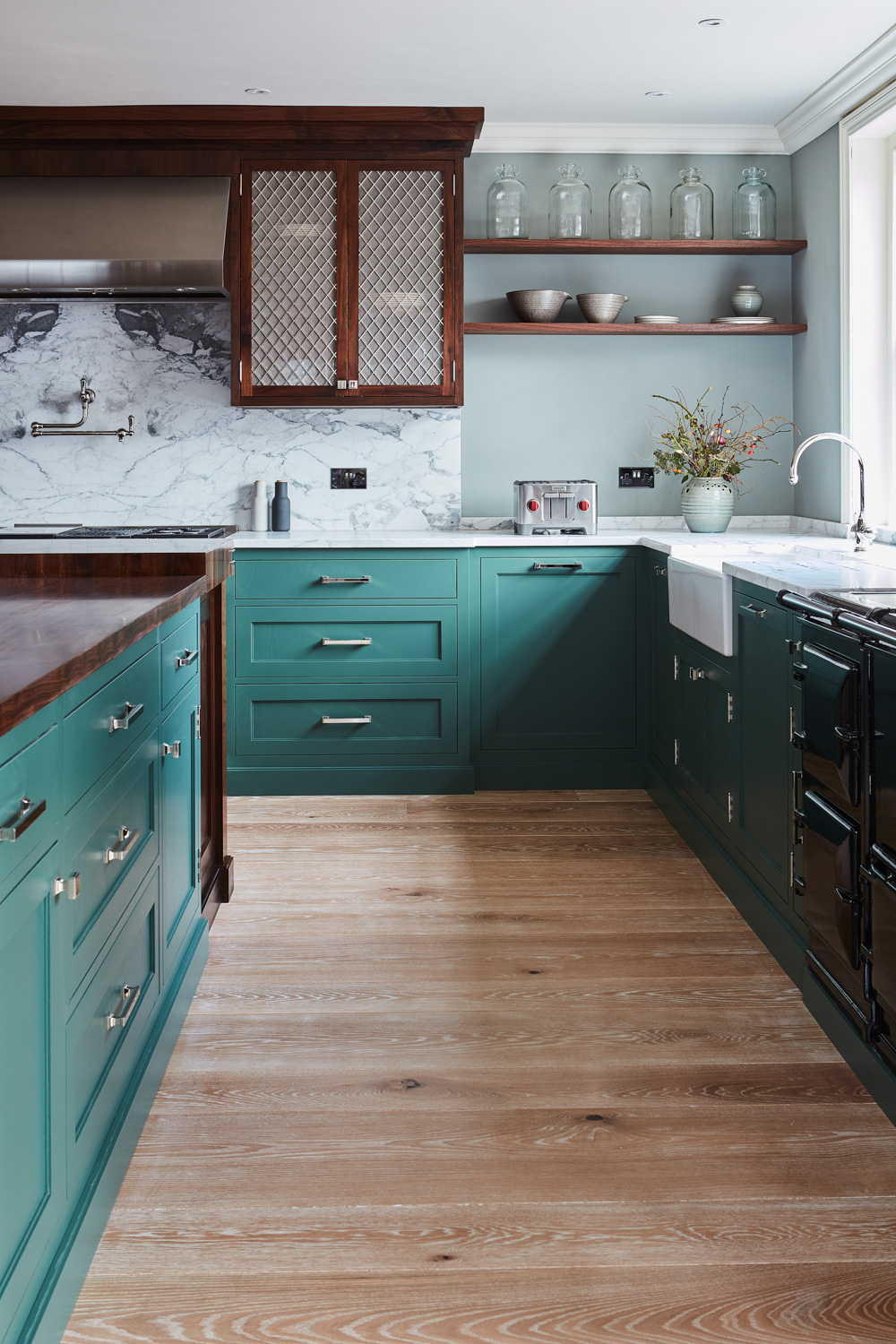
Emma Hughes, Studio Manager at Original Style, adds: 'Kitchen floor tile ideas are a great investment and natural textures such as wood and stone effects create a soft, neutral base to build upon.
'Patterned floor tiles are also a great choice for kitchens as they add interest and texture. To achieve a softer style, team plain wall with a panel or section of patterned tiles.'
Should flooring be lighter or darker than cabinets?
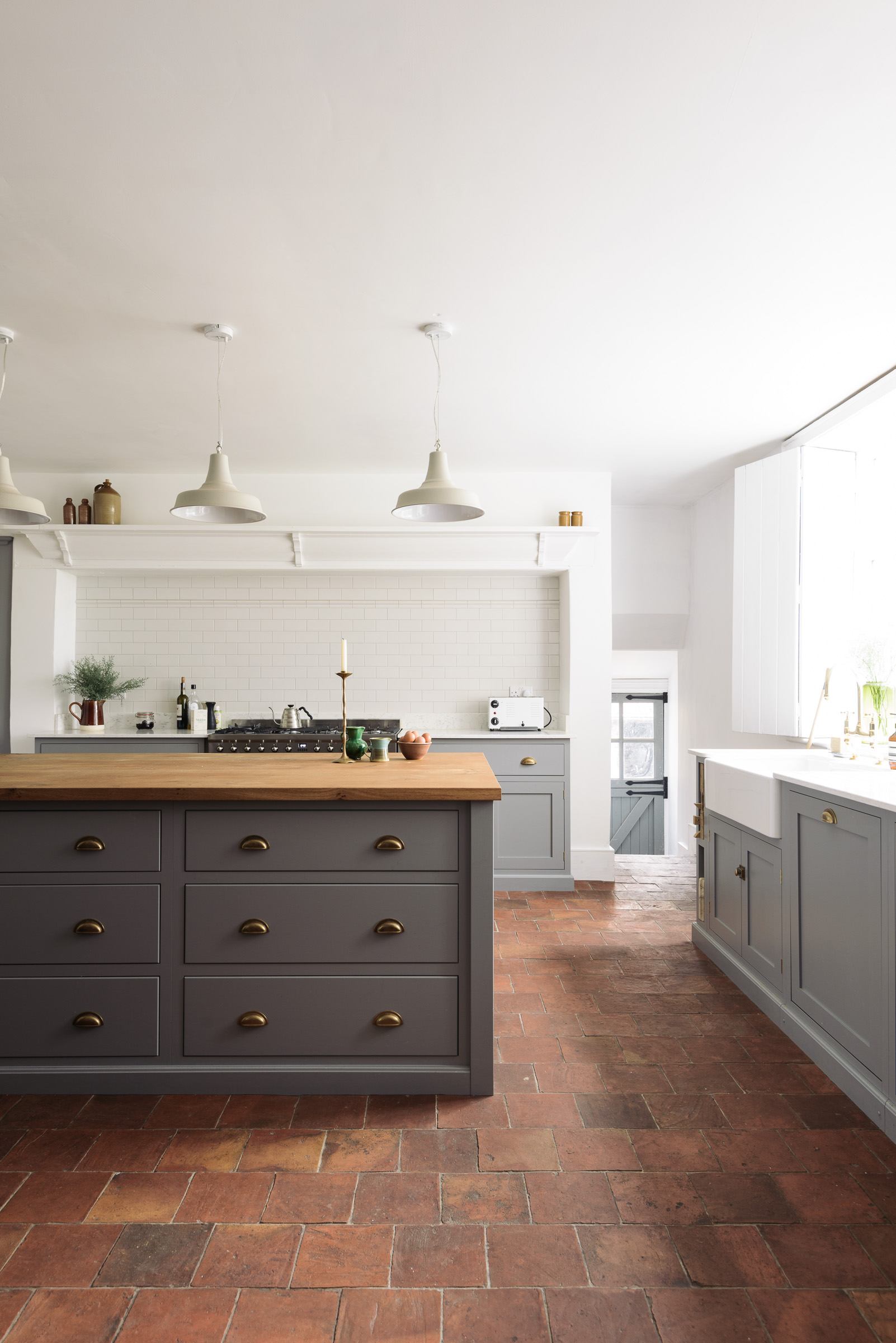
Oanu Sandu says: 'It doesn't matter so much if you choose a light or a dark floor for your kitchen, but whatever you do choose we would always suggest that the floor offers a contrast to the cabinetry.'
Emma Hughes adds: 'Opting for a neutral floor is a great way to ensure longevity. A lighter toned floor will help to accentuate cabinetry in bolder shades and a darker floor will add contrast to white, cream and light grey cabinets.'
Should kitchen countertops match the floor?
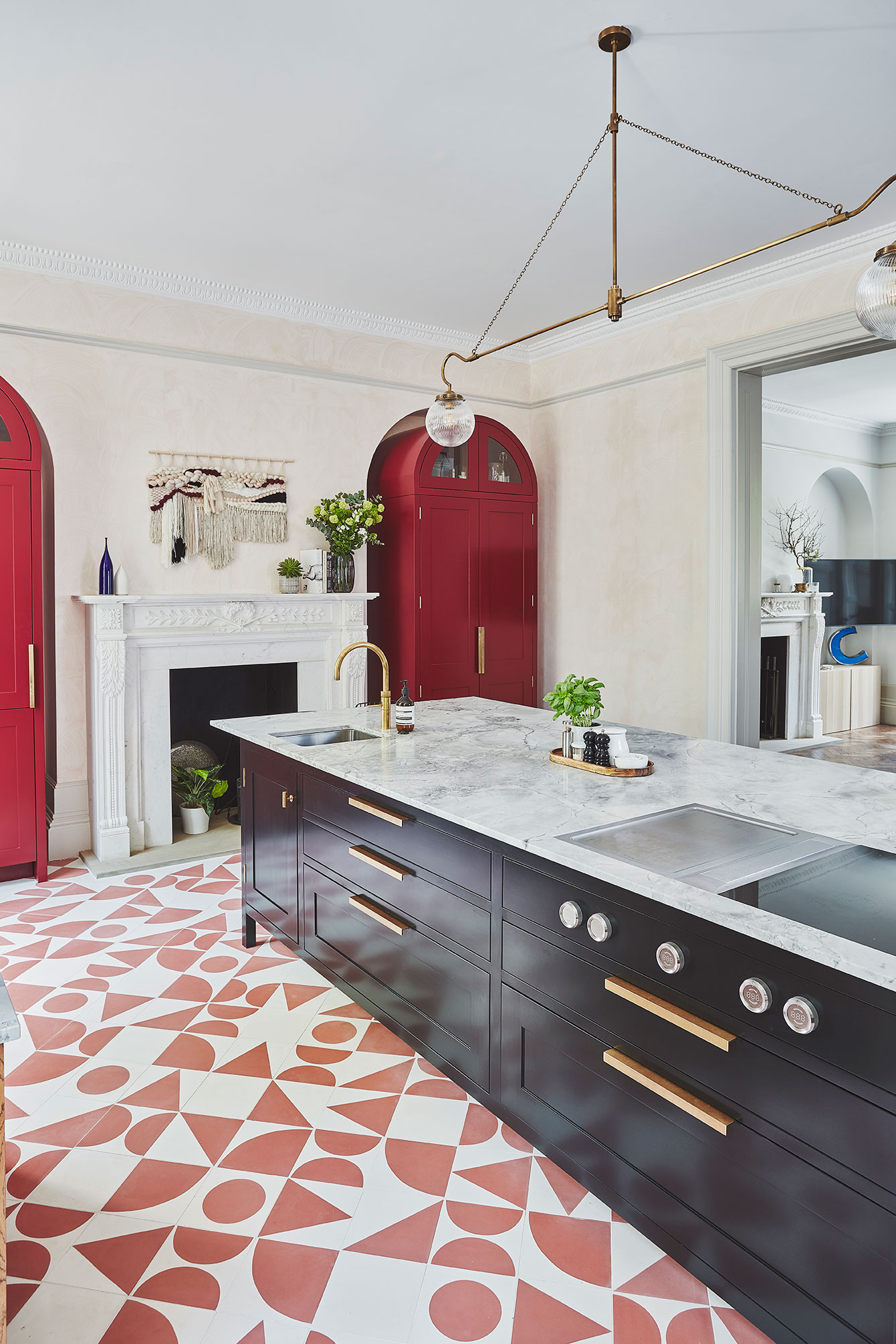
Your kitchen countertops should ideally not match the floor,' says Blake London's Oana Sandu. 'We like to use a mixed pallet of materials in a kitchen to offer visual interest and a depth of perspective in a room.
'In fact, in the majority of our kitchens we recommend one type of worktop surface one the wall run, and another type of material on the island to keep things interesting.'
Elizabeth Sherwin, of Naked Kitchens, agrees: 'Worktops certainly don't need to match the flooring; if anything this can make the task of selecting materials extremely difficult. Unless you are using exactly the same material, it can be very tricky to achieve an exact match.'
And Original Styles' Emma Hughes says: 'Depending on the scheme of your kitchen, matching worktops to flooring can help to create synergy and a coherent feel. If you’re opting for a bolder floor tile, it’s worth considering the tones of your cabinetry and worktops so they all complement each other.'
What is the easiest kitchen floor to maintain?
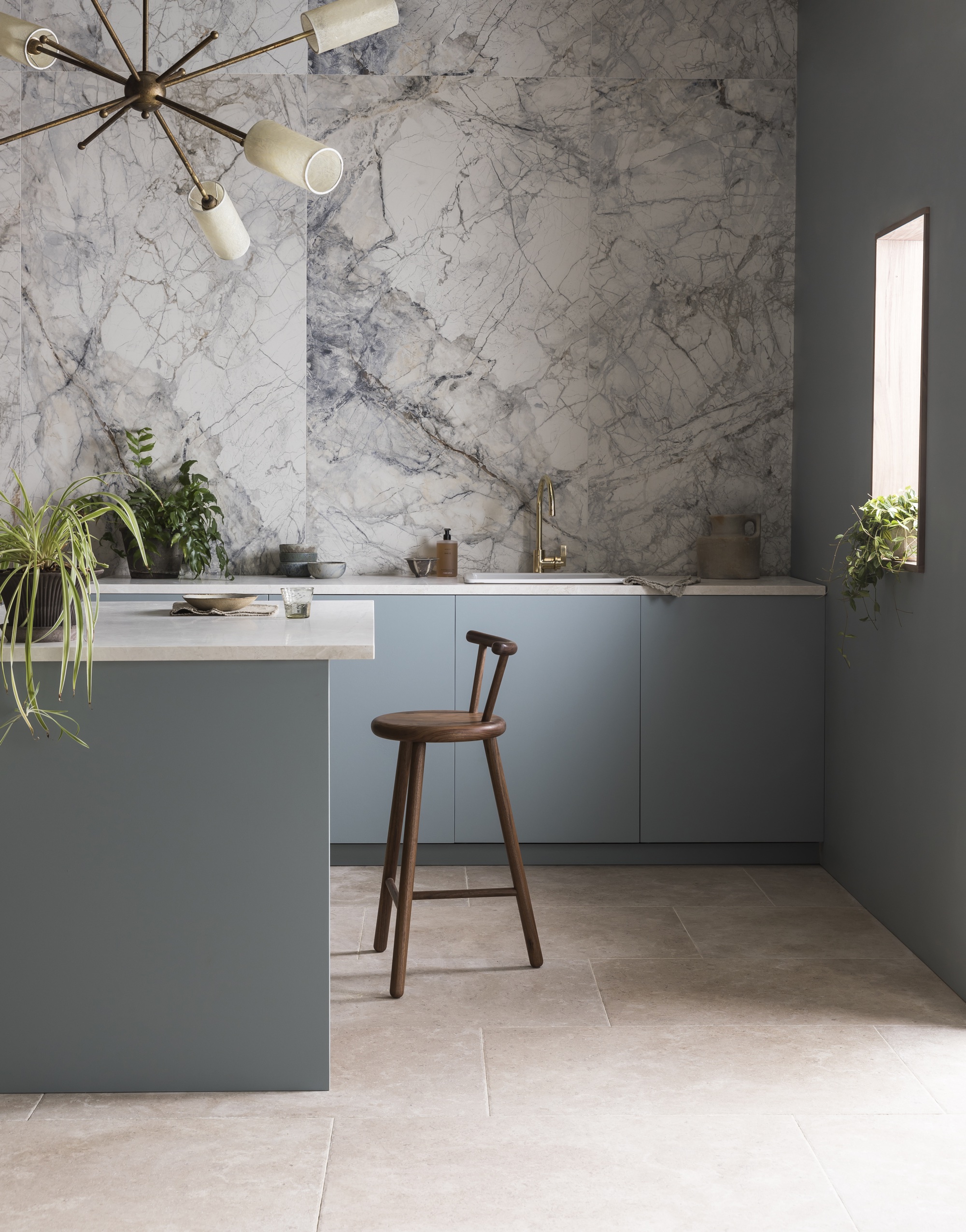
'The easiest kitchen floor to maintain is probably a large format matt-finish porcelain tile,' says Blake London's Oana Sandu. 'Not too many grout lines, easy to maintain regularly with a steam mop and relatively resistant to stains.'
Emma Hughes agrees, saying: 'Choosing large-format floor tiles will result in fewer grout gaps and create a seamless space that requires less cleaning and maintenance, ideal for busy kitchens!
'Porcelain tiles are perfect for floors, their hardwearing qualities are great for the traffic of everyday life and come in a number of colors, effects, and finishes.
'Continued advances in technology mean that you can now choose tiles made from porcelain that look and feel like natural stone (see above), whilst maintaining all the practicalities of porcelain such as easy installation and low maintenance aftercare. You don’t have to worry about a tile looking exactly like its neighbor either, as often color options come in several versions. This helps repeat patterns and gives an even more convincing final result.'
Grazzie Wilson agrees, commenting: 'Porcelain tiles are typically wipe-clean and easy to maintain, which is why they are great options for floors.'
However, if you're prepared to apply a sealant, then natural stone is also a lovely option, offering longevity if a little more effort at the laying process.
Grazzie explains: 'Natural stone will need sealing to ensure that the surface of the tile is protected. This is mostly in the form of an impregnator that fills the pores in the stone to make it impermeable to stronger colors penetrating into the stone.
'Lay the floor, seal it, look after it by vacuuming and washing as you would with any other floor finish and it will withstand the most robust of lifestyles, history has proved this.'
Can you use ceramic tiles for kitchen flooring?
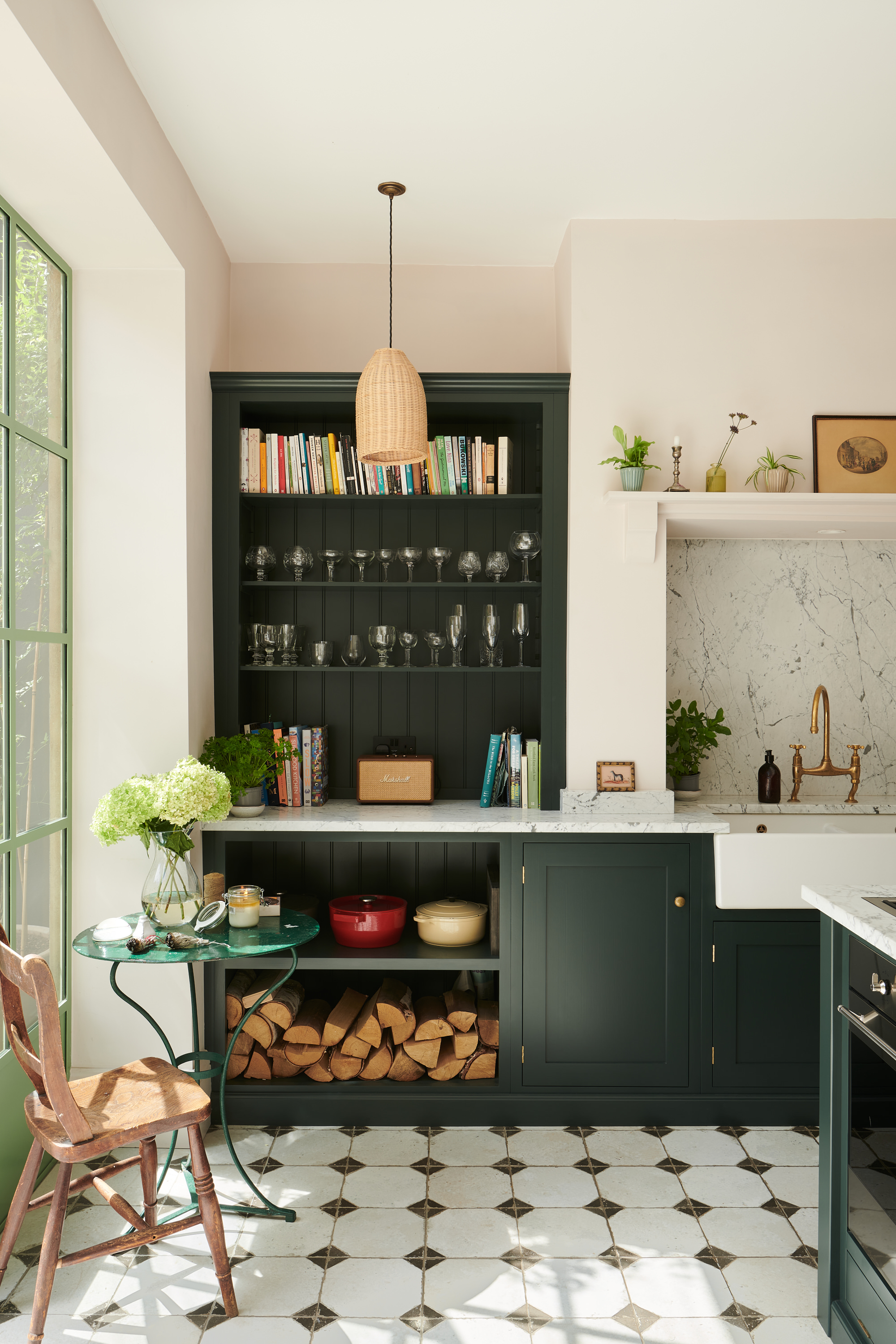
The short answer is yes. Ceramic tiles offer a range of stunning colors and patterns, however are not as durable as porcelain, and many experts wouldn't recommend them for kitchen flooring.
'People do use ceramic tiles,' says Oana Sandu, 'but they are prone to staining with oil and more likely to chip and get damaged if something heavy falls on them. There can also be issues with color consistency unlike a porcelain, which will be more consistent throughout.'
Louisa Morgan, of Mandarin Stone, suggests ceramic tiles are better used for walls if you don't want that lived-in look, adding: 'These generally have a higher porosity so not usually used for flooring, mainly walls.'
What is the best flooring for small kitchens?
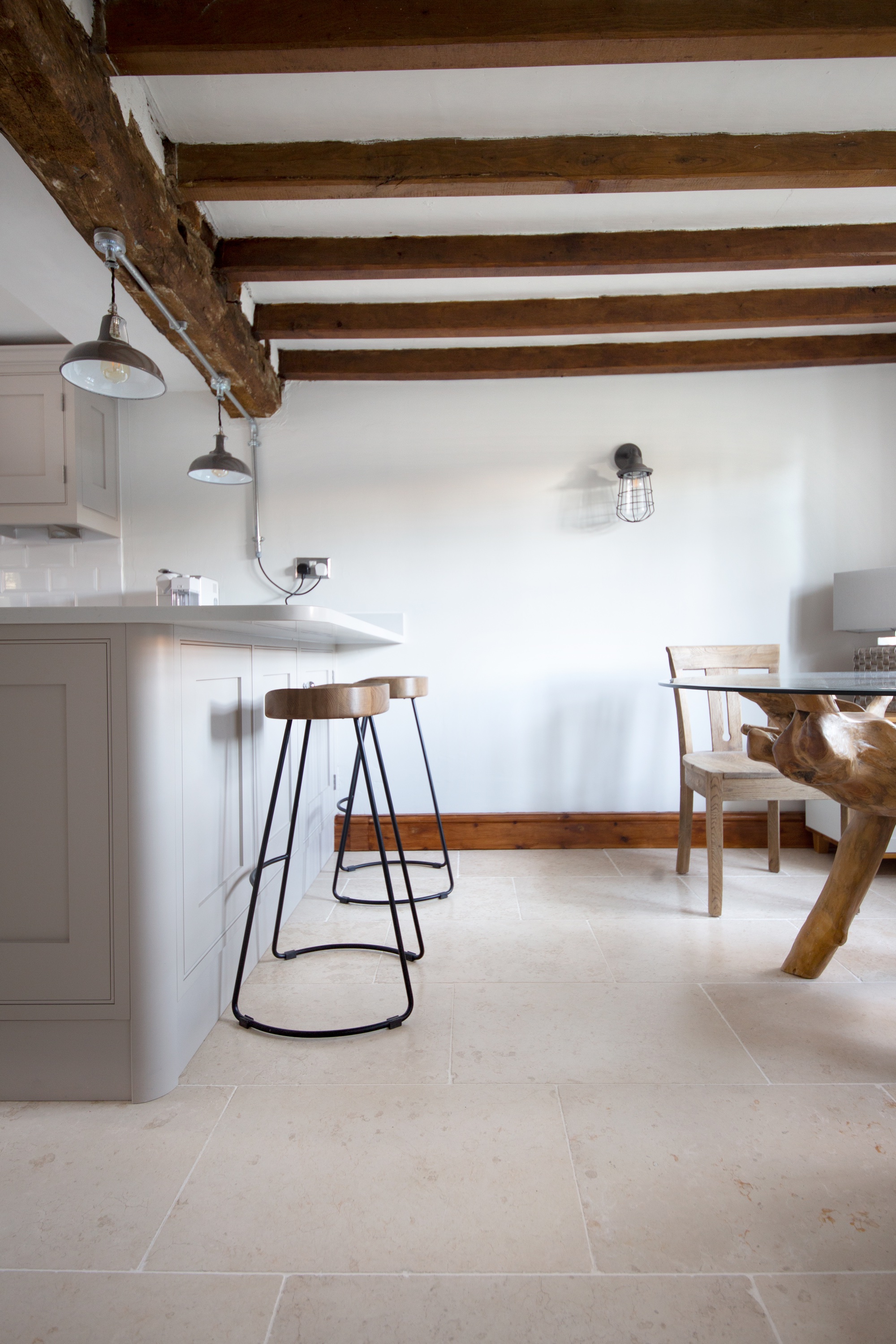
Short on space? Do the opposite and go big on tiles, says Isabel Fernandez, Director at Quorn Stone.
'A smaller kitchen requires careful thought and consideration to give the illusion of a larger space,' she explains. 'Contrary to belief we often find a larger tile can work well at achieving this. A smaller tile results in lots of grout joints which can enclose the space and detract the eye from the tile. We often suggest a 900 x 600 tile as it is a versatile size that works well in both smaller and larger areas.' A key fact to add to your small kitchen tile ideas.
'Alternatively wood-effect porcelain is becoming increasingly popular in tighter spaces due to their long and narrow format – if you choose a complementary grout color it makes the grout less noticeable which again helps to open the space out.'

However, maximalists need not despair, as small kitchen floor tile ideas can also be expressive and make a design statement. As the space is small, a bold pattern won't be too overpowering - so feel free to go wild.
Be The First To Know
The Livingetc newsletters are your inside source for what’s shaping interiors now - and what’s next. Discover trend forecasts, smart style ideas, and curated shopping inspiration that brings design to life. Subscribe today and stay ahead of the curve.
Ruth Doherty is a lifestyle journalist based in London. An experienced freelance digital writer and editor, she is known for covering everything from travel and interiors to fashion and beauty. She regularly contributes to Livingetc, Ideal Home and Homes & Gardens, as well as titles like Prima and Red. Outside of work, her biggest loves are endless cups of tea, almond croissants, shopping for clothes she doesn’t need, and booking holidays she does.
-
 Turns Out the Coolest New Café is Actually In Your Kitchen — Here's How to Steal the Style of TikTok's Latest Trend
Turns Out the Coolest New Café is Actually In Your Kitchen — Here's How to Steal the Style of TikTok's Latest TrendGoodbye, over-priced lattes. Hello, home-brewed coffee with friends. TikTok's 'Home Cafe' trend brings stylish cafe culture into the comfort of your own home
By Devin Toolen Published
-
 5 Bathroom Layouts That Look Dated in 2025 — Plus the Alternatives Designers Use Instead for a More Contemporary Space
5 Bathroom Layouts That Look Dated in 2025 — Plus the Alternatives Designers Use Instead for a More Contemporary SpaceFor a bathroom that feels in line with the times, avoid these layouts and be more intentional with the placement and positioning of your features and fixtures
By Lilith Hudson Published